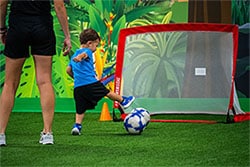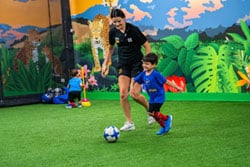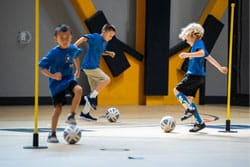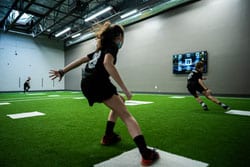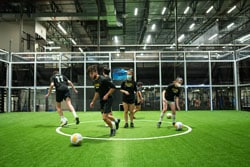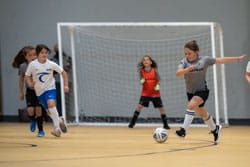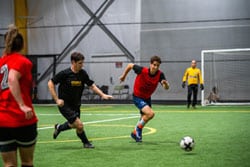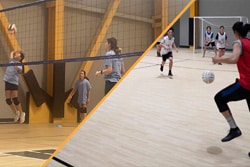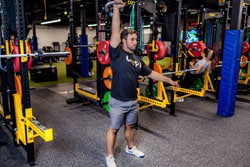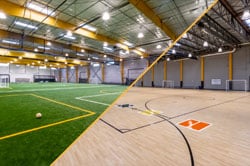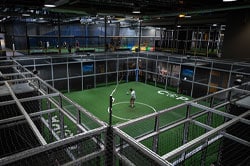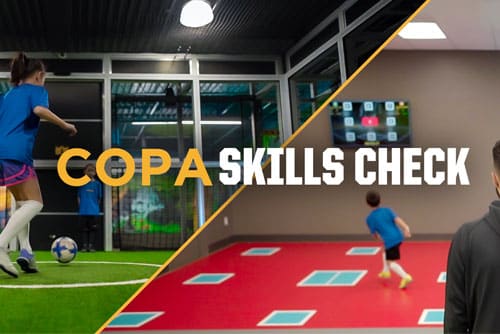The COPA Score – Scorecard
This gamified information is a comprehensive breakdown of the COPA Score highlighting the key categories of an athlete’s soccer skills.

Transforming the Game
COPA’s mission is to transform the game’s subjective approach to player development and player identification with an objective data-driven approach in order to give everyone an equal opportunity to achieve their goals. This pioneering evaluation is the COPA Score and is meant to quantify an athlete’s skills, identify areas for development, and create a baseline for each player to work from.
We present this critical information in an accessible and comprehensive format – the Scorecard.
The Scorecard is a gamified document designed to provide an athlete with concrete data on their overall performance, a breakdown of their individual scores, a comparison to their peers in order to objectively track current performance and continued development, and suggested development areas and training recommendations. This actionable information is key because learning and growing can only happen when the player gets feedback and is provided with clear goals.
Overall Snapshot
The first image presented to an athlete on the Scorecard is a snapshot of their most recent assessment performance. Featured in the hexagon will be three key points of information: the name of the athlete, their overall score, and a numerical breakdown of the seven categories that formed the overall score. The top number is the cumulative average of the athlete’s performance, which provides COPA with an objective number to base the athlete’s training level. The seven categories below the name are valuable measurements for an athlete’s assessment and development. Each number next to the category represents the athlete’s score for that particular measurement.

We also provide the athlete’s age, date of the latest assessment, protocol age level, and a profile link. The protocol will be one of two age groups: 9-11 and 12+. This allows COPA to properly group the athlete based on their age. The profile will be coming soon and feature videos, long-term scores, past developmental recommendations, and more.
At the bottom of this section is the athlete’s Training Level. This is based on soccer skills alone since the score influences which classes and clinics are recommended. A physically gifted athlete that has never played soccer and a skilled soccer player that is physically underdeveloped may have similar scores, but would not respond to classes equally.
Training Level Score Breakdown:
- Level 1: 0-30
- Level 2: 30-55
- Level 3: 55-80
- Level 4: 80+
Performance Scores
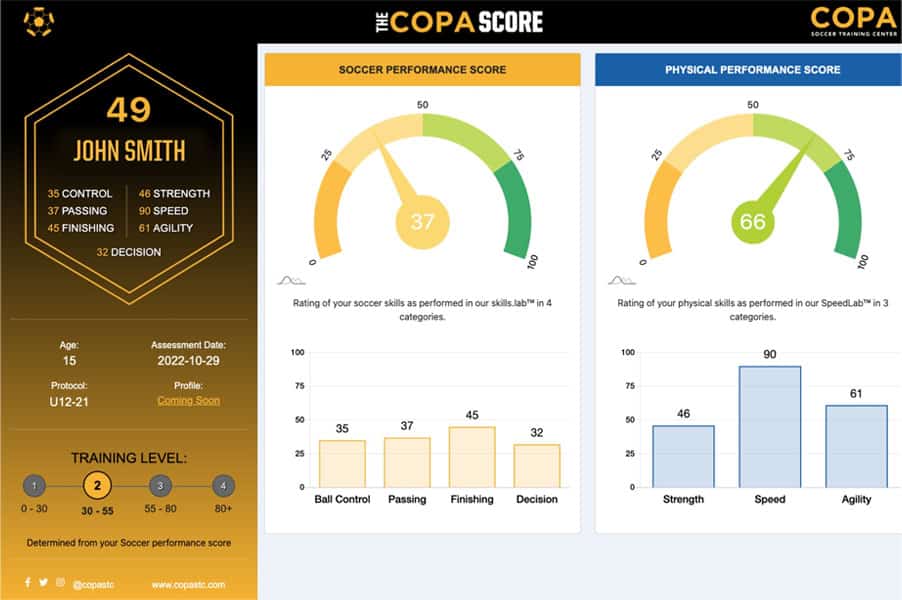
Next is the athlete’s Soccer Performance Score. This is based on their four categories of key soccer skills performed in the skills.lab Arena: ball control, passing, finishing, and decision-making. These four are universally accepted soccer measurements for overall performance. This allows us to repeatably assess an athlete’s strengths and weaknesses with confidence and provide solutions to further their training.
After completing the 8 different exercises in the skills.lab Arena portion of the COPA Score, the performance metrics are averaged for each of the four categories. These are then averaged together to create the Soccer Performance Score.
Similar to the data-driven approach of the Soccer Performance Score, the Physical Performance Score is based on the physical scores in three categories during the SpeedLab portion of the COPA Score: strength, speed, and agility. The categories receive averaged numbers, which are then averaged together to form the total score.
These tests have been performed over 15,000 times to provide a massive database to compare each athlete. The next section of the Scorecard takes that comparison a step further and breaks down the athlete’s performance compared to their peers.
Comparative Skills
Every athlete wants to know how they measure up to their peers. This part of the Scorecard provides a breakdown of the seven key categories and where each performance falls. Because we have gathered information from thousands of assessments of athletes of all ages and skill levels, we can compare an athlete’s performance against those of a similar age to see how they match up. An athlete can see if their performance in a given category needs development, is below average, above average, or excellent for their group. This allows us to highlight where they excel, aspects of their game that need improvement, and how they stack against the competition.

We take all the scores and compare them to other athletes of the same age and preferred gender identity. For example, John is 16 years old, so his score would be compared to every other 16-year-old boy that has completed the COPA Score. Samantha, a 12-year-old girl, would be compared to other girls that are 12.
This is represented at the top as N=x. X represents the number of peers that match the athlete. This dynamic number is ever-increasing with each assessment, allowing our database to continuously grow and develop.
The comparison table at the bottom of this page provides a breakdown of the seven categories and how the athlete measures up against their peers, COPA athletes, college athletes, and even professionals.
- Current Score is the athlete’s score in each category
- Age Group Average is the overall average score of all athletes of the same age and gender
- Age Group Best Score is the top performance in each category based on age and gender
- College Average is the average performance of that category of all the college-level athletes that have completed the assessment
- Pro Average is the average performance of that category of all the professional athletes that have completed the assessment
Features Coming Soon:
Training Recommendations

Once the strengths and weaknesses are identified, we can customize training sessions and a development plan. This section of the Scorecard is designated to provide an athlete with suggested training opportunities based on the assessment scores in comparison to their age and gender grouping. We provide guidance and necessary tools to help the athlete continue their development. There will be two recommendations based on their skills performance and two based on their physical performance.
History
One of the core elements of the COPA Score is its repeatable nature. By assessing, comparing, training, reassessing, and so on, the assessment provides the opportunity for constant and continued growth. This section utilizes previous assessments to create a chart highlighting the development of each category. The focus here is to demonstrate the continued development of the athlete in all the categories and their improved overall performance.
Development Gamified
By gamifying the critical information in the development of an athlete, the Scorecard provides objective data in a comprehensive platform that highlights an athlete’s strengths and weaknesses. This helps determine where the athlete is at in comparison to their peers and provides actionable information to help them learn and grow.
To learn more about COPA STC’s bright future, please check out:

